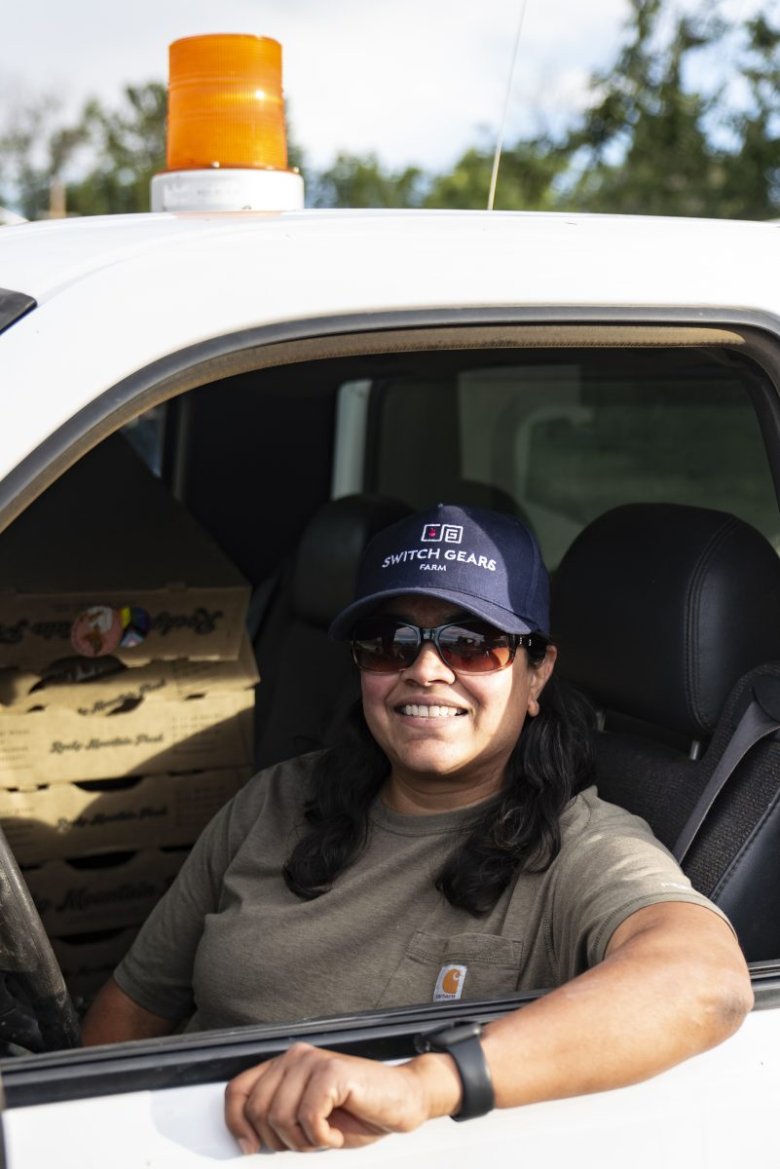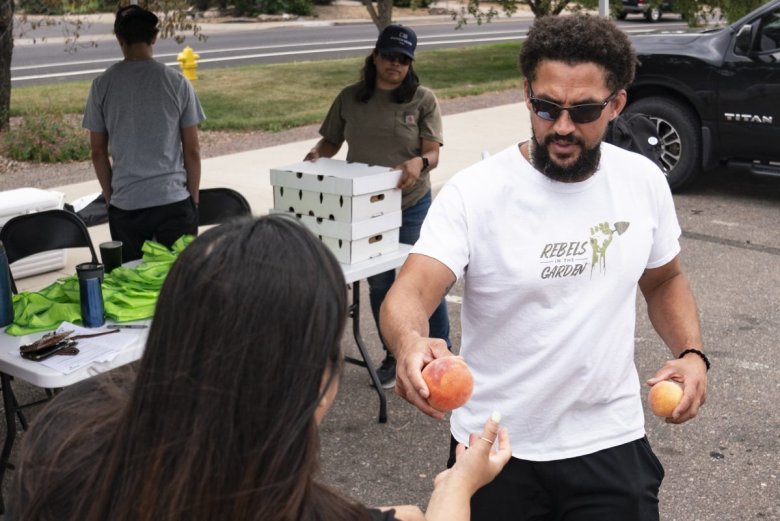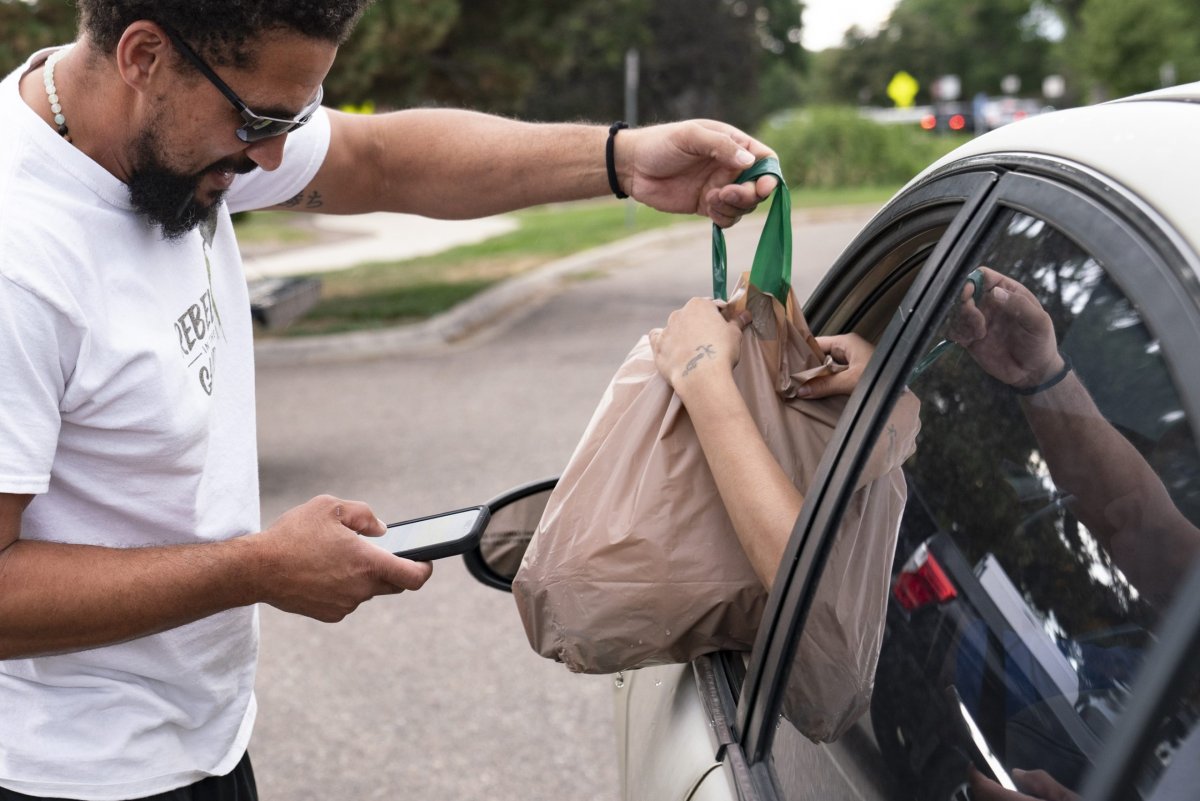AURORA — On Wednesday evenings at the edge of a wide parking lot in Aurora, there is a forest green pop-up tent with five large, scraped-up coolers stacked nearby. The coolers hold 27 bags of fresh produce, harvested that morning at Switch Gears Farm in Longmont.
The arugula gets picked first, Vanita Patel, co-founder and co-owner of Switch Gears explained. The farmers chop the spicy leaves down early in the morning while the air is still cool, soak them in cold water for an hour then spin them dry, rinse again and bag it all up. The potatoes and shallots are pulled straight out of the ground and thrown into the bags — the dirt on their skin helps them keep fresh longer. There are heirloom tomatoes and two shades of beets. There are also a couple of plump, round Baingan eggplants that Patel is especially proud of. It took her four years to find the seeds, she said.
“We take our varietals very seriously,” she told a group of stakeholders and policymakers who were circled up next to the tent Wednesday, including state Sen. Rhonda Fields and a district leader from U.S. Rep. Jason Crow’s office.

The bags of produce were to be handed out during a two-hour window to people enrolled in the Women, Infants and Children federal food assistance program. That produce is paid for by Nourish Colorado, a food equity and advocacy group, using funds from the Local Food Purchase Assistance Cooperative Agreement Program, known as the LFPA.
These funds have bolstered local agriculture and supported low-cost food distribution for the past three years, but they’re about to run out with no replacement in sight. And that’s why the government workers were gathered in the Aurora parking lot, to hear from Nourish and the farmers about what comes next.
What is the LFPA?
The LFPA is a pandemic-era relief program overseen by the U.S. Department of Agriculture. Nationally, the program has issued more than $900 million to state governments, tribes and territories for food banks, pantries and distribution sites to buy produce from local farmers.
Colorado was one of the first states to receive funding, and over the past three years has received and distributed close to $10 million in LFPA funds. The state has passed the money on to 35 grantees in the food supply chain.
Two things set the LFPA apart from other food security programs. First, its direct support of local agriculture. Grantees are required to purchase food from producers within 400 miles of the distribution site.
Second, the funds are intended to support “socially disadvantaged producers,” which, according to the USDA, includes veterans, women, people of color and people with disabilities, among other groups.
According to the Colorado Department of Human Services, of the 220 producers who sold to LFPA grantees, 147 of them, or 67%, are considered “socially disadvantaged.”
The middle section
That 67% includes Patel, the Switch Gears farmer. Or, in her words, “I check a lot of the boxes, in terms of diversity.”
One thing that Patel thinks needs to be reconciled between the LFPA grantees, like food banks, and the small, “socially disadvantaged” farmers is that these farms don’t always have the resources to provide cheap food to a large community in need.
☀️ READ MORE
“I can’t sell these boxes for $10 or $15. There is already so little profit being made,” she said. “But when food banks get these grants, there’s this comparison to big farms. They can give much more produce, and it’s like, ‘yes, because they’ve been in Colorado for 100 years, and they own their land, and they own their water rights.’”
The ability to scale doesn’t just require more land, it also requires equipment and infrastructure. Things like cold storage, packaging facilities and delivery vans.
“I don’t need my own delivery van,” Patel clarified. She thinks there’s a way for organizations and small farmers to collaborate when it comes to these improvements.
“Up in Boulder County, we’ll literally text each other, ‘storm’s coming your way,’ because we can see each others’ properties,” she said. “If I had access to a delivery van, or cold storage I could share it with other farmers. That would be so much better.”

This sentiment was echoed by Maggie Kinneberg, a researcher for the Donnell-Kay Foundation, a nonprofit that supports funding for food systems work. An area that is overlooked — in food systems in general, not limited to LFPA recipients — is what she calls the “middle” segment of a farm-to-fork journey.
“I think there’s a friction point not just for new farms, but also for those that are established and looking to scale, that they don’t have access to infrastructure,” Kinneberg said. “And when I say infrastructure, I mean buildings and equipment, but I also mean some of the technical systems like inventory management, accounting, HR, some of those basic things that you need to run a functioning business.”
Two different models
Although the reporting process is standardized by the USDA — that is, reporting who and what the funds are spent on — pretty much everything else is up to the states and their grantees.
Colorado decided to use an open application system, inviting food producers and distributors to apply for the nearly $10 million to spend directly on food during three rounds of funding.
Nourish Colorado worked with their partner distributors, places like the East Denver Food Hub, to apply for separate grants, stretching the money further and using the established sites.
Another recipient, Care and Share Food Bank for Southern Colorado, created an entirely new system to distribute nearly $1.8 million in LFPA funds.
Now in its 50th year, Care and Share has the traditional food bank model down pat. They buy in bulk from larger farms, like Yoder Family Farms in Trinidad, truck the food to one of three distribution sites, sort it, then ship it out to 293 food bank partners.
But with the LFPA’s emphasis on small, socially disadvantaged farms, Care and Share needed a way to buy food in smaller quantities from the often isolated farms around southern Colorado.
So they took the distribution centers out of the equation. Instead, they gave local food bank partners a budget to spend at the selected farms.
For example, if Care and Share had $50,000 in LFPA funds for “Farm A” and there are five local food bank partners in that area, then each food bank will have $10,000 to spend on food at that specific farm, Nate Springer, president and CEO of Care and Share, explained.

Not only does this cut down on infrastructure and transportation needs, but it also gives the food banks autonomy to decide which foods are culturally relevant to their communities.
“We work from Monument to New Mexico, and from Utah to Kansas. There is a lot of diversity in that area,” Springer said. “So when we find these farmers, I don’t want it to be up to Care and Share to figure out what our partners (the food banks) need. They know better than we do.”
What happens next
When and whether the LFPA funds continue depends on how the election shakes out in November, and what the House and Senate Agriculture committees look like (Colorado Rep. Yadira Caraveo serves on the House committee, Colorado Sen. Michael Bennet serves on the Senate committee), and who the Secretary of Agriculture is in January, said Wendy Moschetti, executive director of Nourish Colorado. “There’s lots of different depends in there,” she said.
The biggest “depend” of all is whether Congress is able to pass the updated farm bill, a bill that sets agriculture and food policy for five-year periods, and is currently in limbo at the Capitol.
Meanwhile, grant recipients in Colorado have spent almost 70% of the LFPA funds, and with one more major harvest season in the fall, the state suspects the money will be gone by the end of the year.
“Long story short is we need continuation of the current LFPA right now, that will last us until we have a permanent program,” Moschetti said. That’s why she invited the political group to hang out in an Aurora parking lot, watching mothers grab bags full of fresh greens and purple potatoes and tiny tomatoes, while their kids snacked on free peaches that a local farmer dropped off.
Springer, of Care and Share, is also eyeing the end of the funding, and has raised about $100,000 in order to continue Care and Share’s new partnerships. He would not name specific foundations that made donations.
Moschetti said that Nourish Colorado’s backup plan is similar to Springer’s: Look to philanthropy.
“I don’t think it’s philanthropy’s job to deal with things the federal government and the state government should be doing, but when there are gaps in government funding, that is exactly when philanthropy needs to step in,” Moschetti said. “And we’re facing a really big cliff right now.”

